I’ve been perplexed and curious about something I watched this pelican do for over six years now. But the purpose I tentatively propose for the behavior I documented in these photos seems more than a little far fetched so I’ve never brought it up.
Until recently I’d largely put it out of my mind but six days ago I posted one of the photos in the series below to Feathered Photography. As a result it’s been niggling at me again so it’s time to put it out there and let the chips fall where they may.
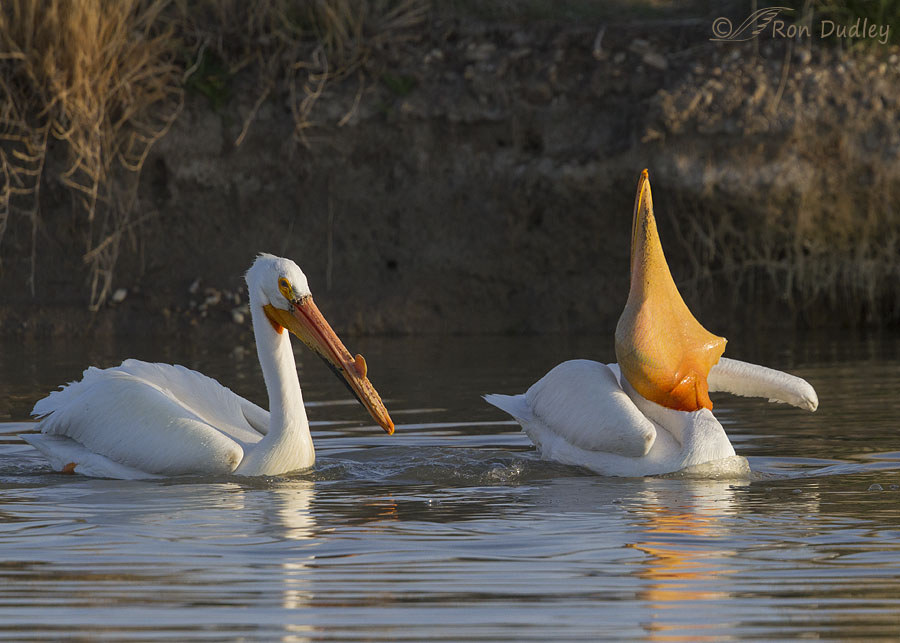
On April 21, 2014 at Bear River MBR I photographed the pelican on the right trying to swallow a huge carp. The fish was so big it seriously deformed the pelican’s pouch. But the size of the fish wasn’t its only problem – the pelican on the left was very aggressive in trying to steal the fish.
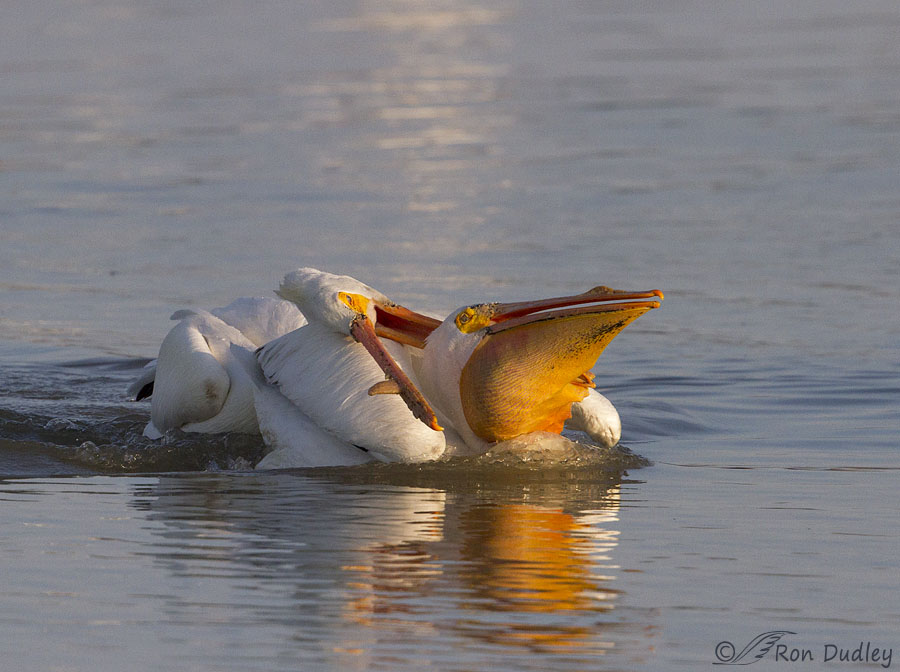
The aggressor turned its head sideways and grasped the head and pouch of the rightful owner of the fish in its bill.
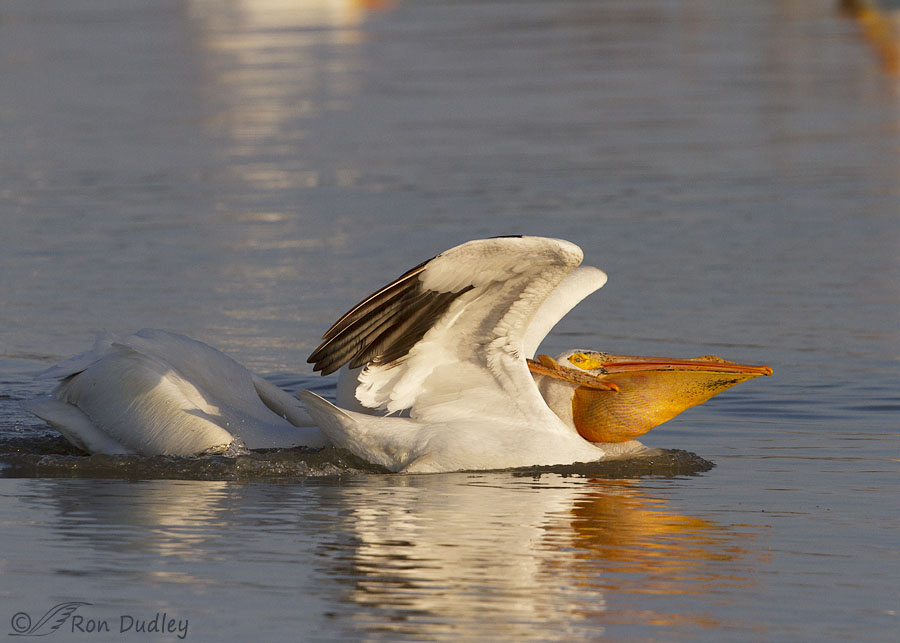
The hook or ‘nail’ at the end of the aggressor’s upper mandible that typically functions as a tool for holding on to slippery fish was very effective in holding on to the pouch of the pelican with the fish.
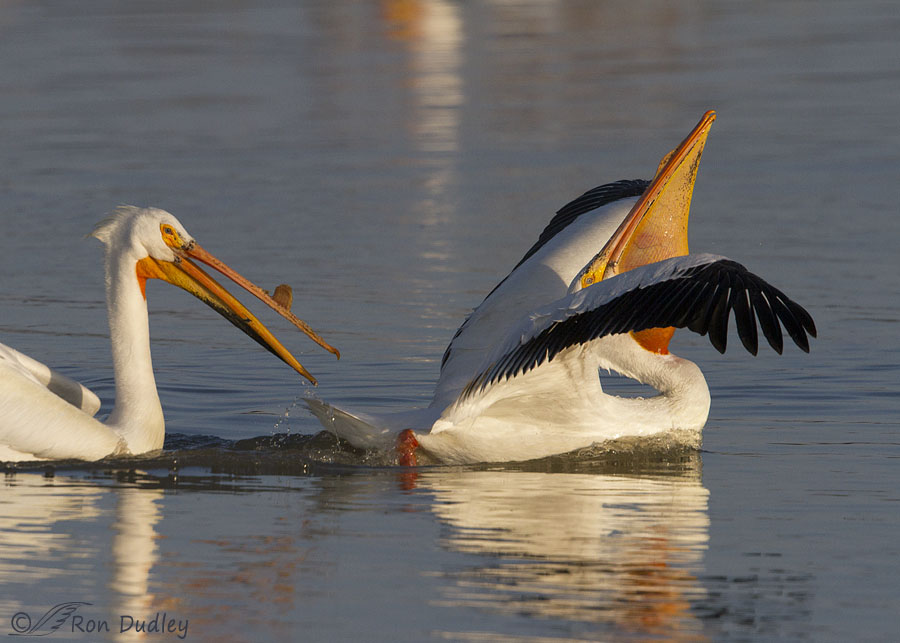
Occasionally the pelican would temporarily escape its tormenter and…
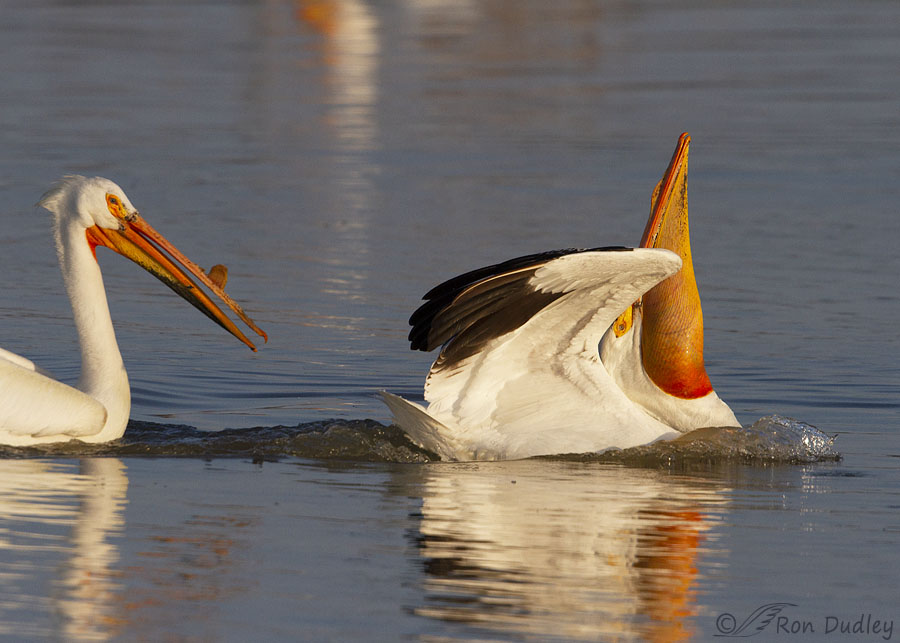
tip its head and bill vertically in order to allow gravity to assist it in swallowing the fish.
This photo is very similar to the next one but I’m including both to show that even though the fish-owner’s wings were raised it made no attempt to take off and fly with the fish.
Could the wings in this position have had another purpose?
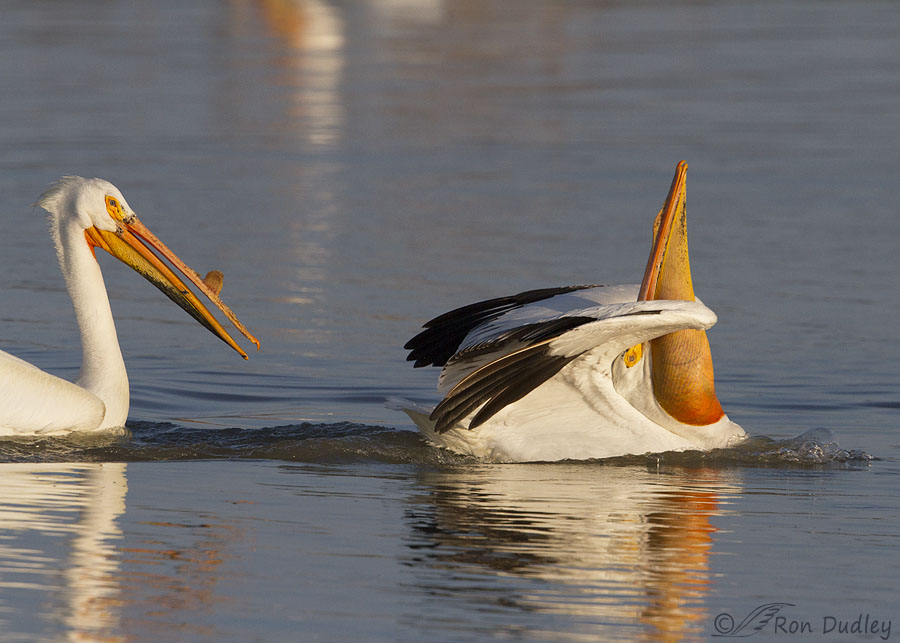
This is the photo I posted six days ago, the one responsible for today’s post and the one that’s key to my question about behavior. In this version I’ve cropped it differently so we can see the pursuing pelican.
The pelican with the fish was desperate to swallow it and end the conflict in its favor, so here’s my question: Could it have been using its wrist joint (some might call it the elbow) to assist in forcing or massaging the fish down its throat – in effect using its wings almost as we might use our hands?
That possibility occurred to me while I was taking the photos in the field and again later that day when I looked at them more carefully on my computer.
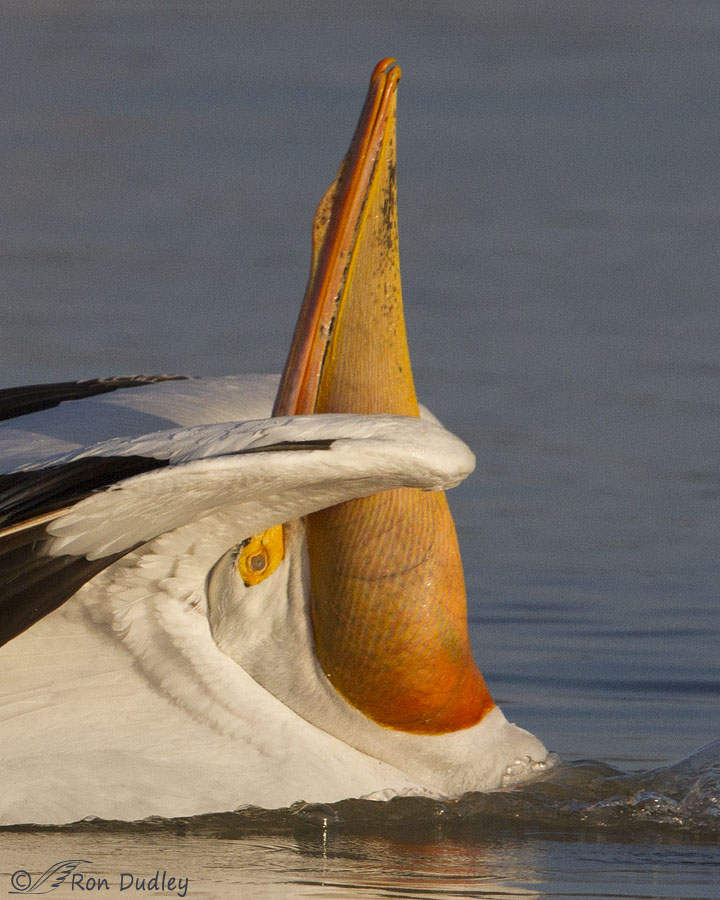
A tighter crop of the previous photo for a little more detail.
In the last two photos the wing joint is at the perfect place on the pouch to push the bulk of the fish down the throat and it’s moving in the right direction to accomplish it but I can’t tell for sure if the wings were pressing inward on the pouch and fish or not. But to me it looks like they’re at least touching the pouch.
I’ve tried doing research to find out if massaging large, difficult to swallow fish down the throat with their wings is a known behavior in this species but came up empty. It seems like a bit of a long shot that I’ve documented a pelican actually doing it but I’d sure like to know if there’s any possibility I have.
Any thoughts from my readers? Are there other instances where birds are known to use their wings for manipulation almost like we might use our hands?
I may wish I’d never brought this subject up but it would be good to get it off my mind, one way or another.
Ron
Notes:
- It occurred to me that another possible explanation for the wing position was to prevent the aggressive pelican from grasping its head in its bill.
- I believe the fish was eventually abandoned because if was too large for any of the pelicans to swallow.


You speculate that the carp was too big to swallow.
Ergo, I speculate that, rather than than using its wings to coax the carp down, the White Pelican was in effect performing a self-Heimlich. Perhaps even using the wrist bones to compress the carp fins to prevent pouch puncture and aid in ejection.
All speculation is welcome Lyle, even self Heimlichs…
Ok.
I have read your post. I have thought. I have read the comments. I have thought some more.
I know not but for a change (not) I am with Laura.
So many species are MUCH more intelligent and forward thinking than we give them credit for.
I am fasting at the moment (an MRI a bit later) but that fish would assurredly stick in my gullet too. I think I would go down the path of trying to get it out rather than down though.
You always have an interesting take on things, EC.
Good luck with the MRI and its results!
Interesting series…all the explanations sound good…that leaves me with nothing….
Thanks, Patty.
Fascinating. Can you see the wrists actually pushing in and down against the pouch? Let me offer an alternative explanation. (Just an alternative, however. Your explanation is equally possible without more study) It looks like the inner portion of the wing is moved away from the body as well. It’s possible that moving the wings in this position expands the furcula (wishbone) tip just enough to allow more room in the gullet for something large to pass more easily. However, that may not be a good explanation either. I haven’t seen a White Pelican’s furcula, but in the Brown Pelican the furcula is large, partially fused to the breastbone and more rigid than in most birds. This allows more protection when such a large bird hits the water from a high dive. But White Pelicans don’t dive from a height and may have a slightly different anatomy in this respect. In any case, it’s an interesting question.
Your alternative explanation is fascinating and one I would never have thought of, Dan.
I’m curious, do you know of any examples were birds are known to manipulate objects with their wings like we might do with our hands? Obviously they manipulate objects with their bills and even with their feet (eggs in the nest for example) but with their wings?
Wings are certainly used for fighting but I can’t think of examples of manipulating objects.. The closest I can think of is Hoatzin chicks. They have a hook on their wings near the wrist, which is lost as an adult. The nests are over water and the young chicks can swim, using their wings. To avoid predators, they sometimes jump out of the nest and into the water. The wing claw is then used to pull themselves out of the water and back up the tree to the nest.
OK, thanks Dan. I can’t think of any either.
I asked Haley while she was here getting birds ready for release. She has worked a lot with pelicans. She said the bird is most likely posturing to keep the other bird away. From the photos angle it is not conclusive if the bird can get it’s wings to it’s neck/pouch, you would need a head on shot. She said she doesn’t know it the bird can rotate it’s wrist toward the pouch, she said next time she was working with a pelican she will check out the ability to rotate that direction.
April, please thank Haley for me and report back if she comes up with any more info.
Well, that’s no fair. Posing questions with no answers. Forcing me to think instead of just sitting back and enjoying beautiful photographs. Nope. Not fair at all.
I have no answers. Of course, now I’ll be heading to our local White Pelican hot spot to try and observe similar behavior.
Behavior photography! Thank you, Ron, for continuing to stimulate us beyond merely gazing at images. (Although, ain’t nothing wrong with that, either!)
“Well, that’s no fair. Posing questions with no answers”
Ha, I had a lot of practice at that while I was in the classroom, Wally.
Thank you, Wally.
I love all the great comments and agree with Laura. I think lay humans when they see specific animal behavior and there is no explanation, sometimes will take the specific behavior as gospel. Science is under another set of rules where they need time and successive observations and explanations along with vetting before it will become accepted. Just my take.
Thanks for your input, Dick.
Fascinating! I definitely have more questions than answers! When I first saw the 5th shot, I assumed the bird had struck this pose to be able to finish its breakfast in peace, but honesty, I have absolutely no idea.
A couple of things that have been nagging at me now:
1. It doesn’t look like “fish-bird” closed its nictitating membrane(s) while being assaulted. Is that the case or are they more transparent than in other birds?
2. The pursuer has one heck of a breeding horn! Fish-bird, not so much. Could Fish-bird be a younger male or a female and that’s why Mr. Big Horn is being such a jerk?
Thanks a lot for making me think (and look stuff up) before I’ve had a cup of coffee!
Marty,
1. My guess is that the membrane is closed in that shot and it’s just more transparent in this species than some others. Notice that the other pelican’s iris appears to be more distinct.
2. Seems to me there are several possibilities to answer that question. I don’t really know.
Hope you enjoyed your coffee as much as I did mine.
What an encounter–what was the marauding pelican going to do–
perform something like a “caesarean” ? I don’t think your intuition is
at all far-fetched. Surely, over the ages a number of pelicans discovered
quite by accident that the maneuver worked, and it may have become
behaviorally encoded ?
“what was the marauding pelican going to do–
perform something like a “caesarean” ”
Kris, I think it was trying to force the other pelican to release the fish.
Hmmmmm. An interesting idea, indeed, but I would ask, “Why not?” In the context of any port in a storm paired with we are far more alike than different, why wouldn’t that pelican use whatever tools are available to help fix the problem? We humans often fail in realizing that critters have a LOT more intelligence than we’re willing to admit.
It’s generally not a good idea to rely solely on observed behaviors because a lot of stuff happens when we’re not looking. Case in point, through the Cornell hawk cams, we learned that in addition to goshawks, redtails also use evergreen branches in their nests followed by deciduous branches later in the nesting cycle. We also learned that the male redtail sports a brood patch along with the female. Neither of these things were reported by observers and we also had an “expert” deny that either was a reality even when presented with the visual proof! So just because the behavior hasn’t been reported doesn’t mean it hasn’t happened!
Wow, I had no idea male red-tails have a brood patch, Laura.
See what I mean?
Birds are resourceful if anything. So why would it not use its elbows to assist in this massive swallowing attempt, sure looks like it to me. I think the wings serving as a barrier to further attacks is a bonus to the swallow assist.
If the pelican had been successful in swallowing this very large carp I wonder how it might have fared? Seems like it might need to shelter in place while digestion took place. Talk about earning your meal.
Dave, If it had been successful I’m sure it wouldn’t have been able to eat another meal until at least the next day.
A question that I for sure can’t answer with any authority. It certainly seems logical that the wings grasping like that could help, but it could also be to keep the bill secure from the attempted thieving of the other pelican. Perhaps some of your readers have had more experience in observing pelicans? The answers should be interesting.
What really amazed me is the illogical attempt by the other pelican in locking his or her bill around the pelicans loaded bill.
Everett, I think the aggressive pelican was attempting to get the other bird to release the fish so the “bad guy” could have at it.
I was thinking a protective thing before you mentioned that possibility tho, unless, you had video, it would be hard to prove one way or another. Always amazes me that they don’t choke on those large fish or, in the case of the first photo, puncture the pouch! An ongoing mystery!
“Always amazes me that they don’t choke on those large fish”
Me too, Judy. I believe their anatomy is specialized to help them avoid it.